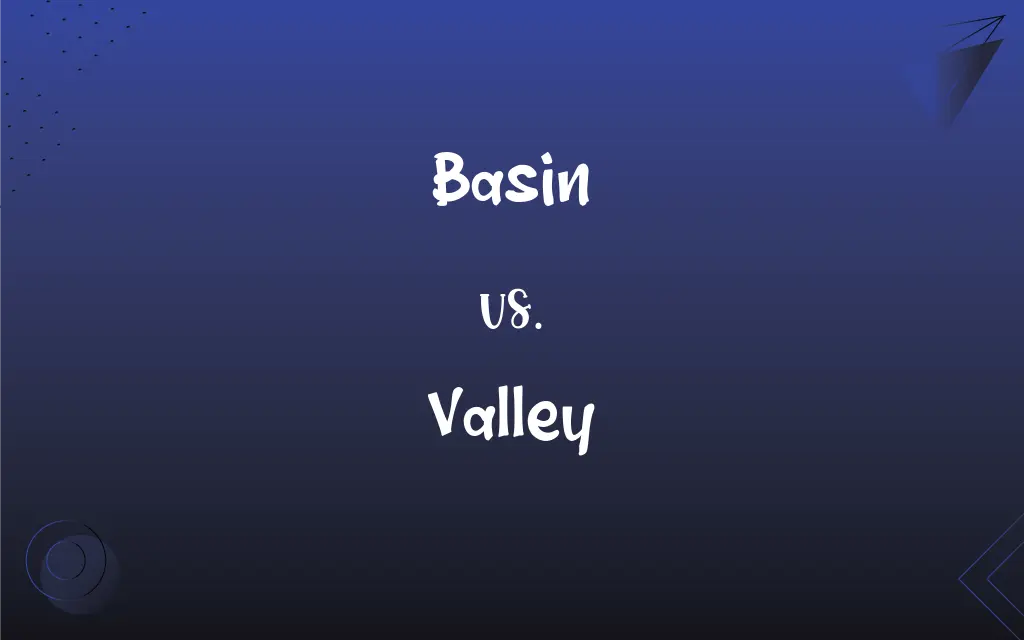Basin vs. Valley: What's the Difference?
Edited by Aimie Carlson || By Janet White || Published on January 1, 2024
A basin is a large or small depression in the Earth's surface, often containing water, while a valley is a low area between hills or mountains, typically with a river or stream flowing through it.

Key Differences
A basin refers to a depression or dip in the Earth's surface, which can range in size from small to very large areas. Valleys, on the other hand, are elongated depressions usually formed by erosion caused by rivers or glacial activity.
Basins can be found both on land and in the ocean floor, and they often contain water, forming lakes or seas. Valleys are typically found on land and are characterized by their length being greater than their width, usually with a river flowing through them.
The formation of basins can occur due to various geological processes, including tectonic movements and erosion. Valleys are mostly formed by rivers cutting through rock or by glaciers carving the landscape.
Basins can have different types, such as river basins which catch water from rivers and their tributaries, or sedimentary basins where sediments accumulate over time. Valleys can be categorized as river valleys, glacial valleys, or rift valleys, depending on their formation process.
In terms of usage, the term 'basin' is also used to refer to a bowl-shaped container, while 'valley' is more exclusively used in a geographical context.
ADVERTISEMENT
Comparison Chart
Definition
A depression in the Earth's surface, varying in size
A low area between hills or mountains
Location
Both on land and ocean floor
Mostly on land
Contains
Often contains water
Typically has a river or stream
Formation
Due to tectonic movements, erosion, or sediment accumulation
Mainly formed by river or glacial erosion
Types
River basins, sedimentary basins, etc.
River valleys, glacial valleys, rift valleys, etc.
ADVERTISEMENT
Basin and Valley Definitions
Basin
A bowl-shaped depression in the Earth's surface.
The Great Basin in the western United States is a vast area.
Valley
A long, narrow depression in the land, typically eroded by water.
A picturesque valley stretched out beneath the mountains.
Basin
A natural depression on the Earth's surface, often containing water.
The basin was filled with crystal-clear water.
Valley
A geographical feature characterized by its elongated form.
The fertile valley was perfect for farming.
Basin
In geology, a region where the Earth's crust has sunk and filled with sediment.
The sedimentary basin has significant fossil deposits.
Valley
A low area between hills or mountains, often with a river running through it.
The valley was lush and green with a flowing river.
Basin
A geographical area drained by a river and its tributaries.
The Amazon basin is rich in biodiversity.
Valley
In geomorphology, a linear-shaped lowland between ranges of hills or mountains.
The hikers descended into the valley as the sun set.
Basin
A circular container used to hold liquids.
She filled the basin with warm water.
Valley
A depression in the landscape, often inhabited and agriculturally rich.
The inhabitants of the valley have a rich cultural heritage.
Basin
An open, shallow, usually round container used especially for holding liquids.
Valley
An elongated lowland between ranges of mountains, hills, or other uplands, often having a river or stream running along the bottom.
Basin
The amount that such a vessel can hold.
Valley
An extensive area of land drained or irrigated by a river system.
FAQs
What is a basin in geography?
A basin is a depression in the Earth's surface that can hold water.
Can basins be found in oceans?
Yes, basins also exist on the ocean floor.
How is a valley formed?
Valleys are usually formed by the erosion of land by rivers or glaciers.
What is a river basin?
A river basin is an area drained by a river and its tributaries.
Are valleys fertile areas?
Many valleys are fertile, especially those with rivers.
What makes a valley different from a canyon?
Valleys are usually wider and less steep than canyons.
Can basins exist without water?
Yes, not all basins contain water.
Is the term 'basin' used in other contexts?
Yes, it's also used for bowl-shaped containers.
What is a sedimentary basin?
A sedimentary basin is where sediments accumulate over time.
Do all valleys have rivers?
Most have rivers, but some dry valleys exist, especially in desert areas.
Are valleys always associated with rivers?
Most valleys have rivers, but not all; some are dry.
Are valleys good for human habitation?
Many valleys are inhabited due to their fertile land and water sources.
Can basins form lakes?
Yes, when basins collect water, they can form lakes.
What's the largest basin in the world?
The Amazon basin is one of the largest in the world.
Are basins prone to flooding?
Basins can be prone to flooding, especially during heavy rainfall.
Are valleys important for agriculture?
Yes, many valleys are agriculturally significant due to fertile soil.
How do basins impact the environment?
Basins can create diverse ecosystems, especially in wetland areas.
Do valleys have specific shapes?
Valleys can be V-shaped (river erosion) or U-shaped (glacial erosion).
Can valleys be found in urban areas?
Yes, cities can be built in valleys, although they may face specific geographical challenges.
Do valleys change over time?
Yes, valleys can change shape and size due to geological and environmental factors.
About Author
Written by
Janet WhiteJanet White has been an esteemed writer and blogger for Difference Wiki. Holding a Master's degree in Science and Medical Journalism from the prestigious Boston University, she has consistently demonstrated her expertise and passion for her field. When she's not immersed in her work, Janet relishes her time exercising, delving into a good book, and cherishing moments with friends and family.
Edited by
Aimie CarlsonAimie Carlson, holding a master's degree in English literature, is a fervent English language enthusiast. She lends her writing talents to Difference Wiki, a prominent website that specializes in comparisons, offering readers insightful analyses that both captivate and inform.






































































